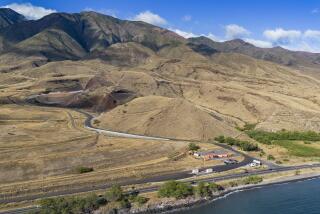Plans for McColl Cleanup Study Revised : New State Notice Describes Various Options for Handling Waste
State health officials have revised their initial plans for an environmental impact study of the McColl dump in an effort to avoid legal challenges that have stalled cleanup of the dump’s toxic wastes.
The toxics division of the state Department of Health Services has sent out a second formal notice of intent to prepare an environmental impact report. The notice, sent by certified mail last Friday, contains a full description of seven possible cleanup options to be studied and possible negative environmental effects that could result from each.
The City of Fullerton, other local agencies and interested parties now have an additional 45 days to respond. State officials said Monday that the study process would be delayed by four to six weeks.
“As far as we’re concerned, any delay is serious,” said James McNally, a project supervisor on the McColl cleanup for the toxics unit office in Los Angeles. “The EIR was scheduled to take a year, so this would add another month to six weeks. . . . Everything gets set back.”
State Was Criticized
Last month, Fullerton senior planner Barry Eaton criticized the state for failing to detail cleanup options. Without such a list, Eaton said, the city could not respond intelligently or assess possible health risks to residents. Eaton warned that a flawed environmental impact study might lead to new court challenges and further delays in the cleanup.
Nestor Acedera, who oversees all toxic site cleanups for the state in Southern California, said Eaton’s letter was referred to the state attorney general’s office. He said the toxics unit was advised to withdraw the first notice and issue a new one correcting flaws cited by Fullerton.
McNally said Kern County officials filed a similar challenge.
A $26.5-million federal Superfund cleanup project to excavate and haul the foul-smelling sludge to a Kern County disposal facility was blocked last May when a Superior Court judge in Kern County ordered the state to do a full environmental impact report.
The McColl dump was created during World War II when oil companies deposited high-octane military aviation fuel waste in 12 leased sumps operated by oil industry consultant Eli McColl.
Expensive Homes
The dump, which lies under a vacant field and part of the Los Coyotes Country Club golf course, is bordered on three sides by expensive homes in northwest Fullerton. Concern over the dump’s noxious odors began when the first homes were occupied near the site in 1978.
The sludge contains sulfuric acid, benzene and arsenic. Before a canvas cover and layers of dirt were placed over the sumps, sulfur dioxide fumes caused residents to suffer headaches, nausea and respiratory problems, especially during hot weather.
Among the options to be studied for cleaning up the dump are:
- Excavation of an estimated 80,000 tons of acid sludge and 120,000 tons of contaminated soil. The waste would be hauled to one of four licensed disposal facilities, including Kern County’s Petroleum Waste Inc. near Buttonwillow, Casmalia Resources in Santa Barbara County, Chemical Waste Management in Kings County and IT Corp. in Imperial County. Risks include the release of air contaminants during excavation, worker and resident exposure to fumes and the potential for spills during transit to a disposal facility.
-Containment on the site, which would involve entombing the waste within reinforced walls and installing a treatment system to collect noxious gases. Problems include possible failure of the tomb walls during a serious earthquake and long-term operation and maintenance.
-Incineration on site or elsewhere, which involves burning the waste as it is excavated. Risks include the release of noxious and potentially toxic fumes during excavation as well as sending contaminants into the air in excess of air quality standards. Off-site incineration adds risks associated with transportation of the waste.
-Thermal processing on site or elsewhere, which involves indirect heating of the excavated waste to extract various chemicals from the sludge. Risks include possible release of air contaminants, worker and public exposure and the potential for spills in transportation.
-Leaving the site alone. Risks include continued emissions of noxious fumes, potential for greater exposure in the event of a large-magnitude temblor and possible contamination of ground water due to underground seepage.
More to Read
Sign up for Essential California
The most important California stories and recommendations in your inbox every morning.
You may occasionally receive promotional content from the Los Angeles Times.










